It is a rare horse that does not have some kind of lameness issue sometime during its working life.
It might be caused by an injury or just from wear and tear on its legs. Horses are like bull riders who keep riding bulls. It’s not a question of if you will get hurt, but when and how bad. If you keep working a horse, eventually you’ll have problems.
Even horses with the best conformation are subject to injury. Lubbock, Texas, farrier and International Horseshoeing Hall Of Fame member Burney Chapman used to say, “Horses are made of iron but are held together by store string.” Horses can come out of horrendous accidents unscathed but can suffer catastrophic damage from stepping on a rock wrong.
There is no holding back the clock for humans or horses. Eventually the joints and soft tissue that worked flawlessly for years begin to not work as well. Cartilage in the joints thins, muscles lose their strength and tendons and ligaments show wear and tear from years of use.
Horses that had done well for years in just conventional keg shoes become no longer usable. My adage is, “If what you are doing isn’t working, change it.”
Optimal management of the older or injured horse requires the services of a team of people. They can include the owner, trainer, groom, vet, farrier, chiropractor, massage therapist and acupuncturist. I will explore some of the options for you to consider.
Identifying The Problem
Anyone who has been shoeing horses for some time knows the scenario well. Upon arriving at a barn and inquiring how the horses you shoe are doing, you’re informed that one of them has had problems during this past shoeing cycle. This might be a horse with good feet that has been wearing open heeled keg shoes with no issues. The owner is concerned and wants results.
The first order of business is to understand what concerns the owner and get a history of what led to the unsoundness. I like to see the horse move and determine for myself how lame the horse is and in what leg.
Pain in a horse’s foot can only come from two places. Either it’s caused by something that is internal in the foot or something that is causing pain from an external source. For the farrier, the first course of action is to eliminate the causes of pain that result from external forces.
Check the shoeing and make sure the current shoes are not causing problems by shifting or the hoof being over grown. If they look good, pull the shoes and do a thorough examination of the foot with a hoof tester. If you can’t find an obvious source of the problem, call the vet to get their opinion as to the cause of the problem.
After the problem is identified, a course of action has to be formulated. The new plan might indicate that the horse can benefit from changing the trim, more mechanics at the toe, more caudal support, less caudal support or some kind of sole protection. Often, these changes can deal with several problems.
What Farriers Can Do
There are only so many possibilities for farriers to influence soundness. They are trimming the foot to change the hoof axis; and applying shoes that provide mechanics for enhanced breakover, provide more caudal support, provide less caudal support, absorb concussion and provide sole protection.
Trimming. The basics of all footwork begin with the trim. Scrutiny should be given to the length of the foot, the angle of the dorsal wall, medial and lateral balance and anterior/posterior balance. The idea is to align the coffin bone in the hoof capsule with the wings parallel to the ground and the solar margins having a positive 3 to 8 degrees parallel to the ground. If this cannot be accomplished with trimming, then you may add a shoe and maybe a pad.
A set of high-quality radiographs is invaluable for determining bone alignment of the leg and the placement of the coffin bone in relation to the ground.
There’s an old saying about the many different ways to skin a cat, and shoeing horses is no different. Most of the time the shoes and products used to remedy a problem follow the same basic principles for what you are trying to accomplish. It is up to you to decide what is the best way of going about it. Each horse will respond differently to various shoes or circumstances. Consequently, there is no perfect shoe, boot, pad or material that is the answer to all your problems. Network with other farriers, go to clinics and read to become better informed.
Here’s a list of several shoes and products that might be beneficial when other options are necessary. It’s by no means a complete list, but it’s a good place to start.
Shoe choice. Shoes are used for the main purpose of providing protection, traction and support. Over the years, my opinion has changed on how best to accomplish these goals. I used to subscribe to the KISS (Keep It Simple Stupid) philosophy of shoeing — using flat, open-heeled shoes with no mechanics at the toe. Over the years I have rethought that idea and now favor a shoe that has mechanics at the point of breakover on the toe. Of course, there are exceptions for horses that need to have traction at the toe. However, most do not.
In addition to mechanics at the toe, I have found most horses, especially those with flat soles, benefit from some kind of sole or caudal support. This acts as an arch support to the foot, which in turn helps support the coffin bone and keep it healthy.
Enhanced breakover shoes. One of the most common problems that cause soreness in horses’ feet is the inability to easily breakover the front of their foot. This can cause premature fatigue, stress on bony and soft tissues and a multitude of other problems.
How easily a horse can breakover its toe is dependent on the surface that the horse is on. A soft semi-deep footing allows the foot to roll over the shoe’s toe pretty much unobstructed, so a conventional keg shoe works fine. If that same horse and its shoes are on a very firm, unyielding surface, the story is different. As the horse goes from the stance phase to the point of breakover, there is a point when there is an abrupt change in the stride. Removing that point allows the limb to breakover in a smooth, continuous motion.
There are several ways to change the breakover at the toe. I will go into them starting at the most gentle and going to the most extreme. Keep in mind that more is not necessarily better. You will notice that as enhanced breakover is increased, so does the thickness of the web. This necessitates the changing of materials to keep the weight of the shoe within reasonable limits.
The easiest and least expensive way to ease breakover is to modify a conventional keg shoe. There are several ways to effectively lessen the leverage at the point of breakover with conventional keg shoes.
Rolled toe. One way is to roll the toe using a grinder or rasp to remove the sharp edge from the shoe’s toe. The disadvantage is that you have removed a good bit of material from the shoes, weakening it and shortening its working life. You can use your hammer to roll the toe, but some stretching and distortion of the toe occurs.
Rocker toe. The advantage to bending a rocker toe is that you still have the full section of steel, but breakover is directed only to the front. When the horse is turning, it will meet resistance on either side of the bend. You should be very careful using a rocker toe on a horse that has its toe trimmed short. It is very easy to invade sensitive tissue.

French roll. When making a French roll (Figure 1), the full thickness of the inside web of the shoe is hammered distally from the quarters around to the opposite quarters. This gives the inside of the shoe a domed appearance on the ground surface. It’s easily done using the ledge at the back of the horn of your anvil. The result is that breakover is all around the front half of the foot and you still have the full section of shoe for wear.
The down side of adding a French roll is that it will raise the front of the foot, rocking it back onto the heel. One solution is to graft a section of steel or aluminum plate onto the heels. I prefer to use an aluminum plate because it is light, easily riveted and wears well.
An even easier solution is to buy shoes with the mechanics already built in. Several manufacturers have steel shoes on the market with mild mechanics built in. Some are the Natural Balance shoes by Equine Digit Support System (EDSS), the Equilibrium by Delta Mustad, the Comfort by Kerckhaert and the Eventer by Delta Mustad Hoofcare Center.
As we move up the scale in enhancing breakover, the next most commonly used material is aluminum. It is light, clean and easily workable. In the past two decades, several companies have come up with similar shoes to achieve enhanced enrollment. Sorting through this maze can take a bit of time, but it’s worth it.

Grand Circuit has the largest inventory with nine categories. They include the Denoix series, Morrison (Figure 2), General Purpose, Heart Bar, Roller Motion, Open Performance, T, Rail and Race. Nanric is not far behind in choices followed by ACR Horseshoes and EDSS.
To get the most enhanced breakover, wood or plastic is used in the Steward Clog. These shoes are used mostly in acute and chronic laminitic cases, coffin bone fractures, ringbone and severe navicular disease. Care must be taken not to overdo the grinding of the toes, sides and heels. This can destabilize the foot and create more problems.
These clogs can be easily fabricated with basic carpentry tools or you can buy them from three sources: Steward Hoof Solutions, EDSS and Equicast.
They can be screwed, nailed, glued or cast on. My experience with Steward clogs is that they are great for acute laminitic and old and fresh chronic cases. I think the real value is allowing a horse to get comfortable and start moving around, which is crucial to a successful long-term recovery. After the case has turned the corner and is doing better, it’s a good idea to reduce the extreme mechanics and transition the feet back to conventional shoes or barefoot.
Caudal support shoes and products. As horses age, tendons and ligaments can become stretched and lose their strength. This often shows up in horses with longer than ideal pasterns. To compensate, extra caudal support can be beneficial.
What you want to provide is “float,” which is the term farriers use to describe the amount a shoe sinks into the ground during the stance phase of a horse’s stride. An open-heeled shoe will sink into the ground at the heels, aggravating some joint and soft tissue problems. To prevent this, some kind of caudal support mechanism can be used. Again, there are plenty of ways to accomplish this.
The easiest is to select a size larger shoe, fitting it full at the heels. Other options are wide web shoes, shoes with onion heels or a bar shoe.
Steel bar shoes have been used for a long time but are gradually losing their popularity because of newer and better options on the market. They have the ability to provide flotation at the caudal aspect of the foot, but do little in absorbing shock.
Shoes with bars between the heels come in many different forms, including straight bars, egg bars and heart bars (full support shoes). I’ve found that some of the more commonly used ready-to-use steel bar shoes are made by Kerckhaert and Delta Mustad.
When applying egg bars to a horse with a weak heel, it’s a good idea to add a frog support of some kind. With the added caudal surface more pressure is applied to the heels, making them crush even more, thus defeating the purpose and making things worse. I also like to slightly roll up the back part of the bar, which makes the heel landing less abrupt.
Aluminum bar shoes have the advantage of being much lighter than steel bar shoes, so they continue to be used frequently. I’ve found that some of the more commonly used ready-to-use aluminum bar shoes are manufactured by Grand Circuit, Kerckhaert, Delta Mustad, Victory, Thoro’Bred, JB Aluminum Bar Shoe Co. and KB Horseshoes.
Pads with heel cushions. Another way of providing caudal support and absorb shock is to use either a pad with frog support or a soft pour material.
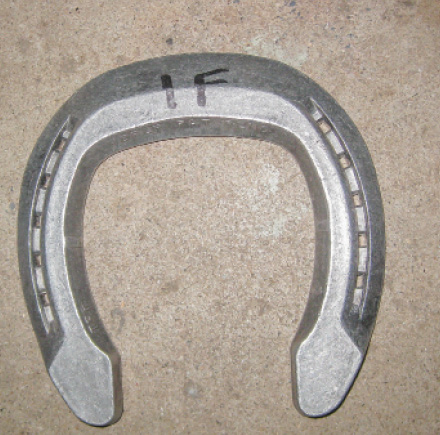
The EDSS PLR horseshoe is applied to enhance breakover, thereby avoiding premature fatigue and stress in the horse’s bony and soft tissues.
There are several good pads on the market with heel cushions to provide caudal support and heel protection. They include Castle Plastics’ frog support pads, Grand Circuit Flappers, Myron McLane pads and EDSS.
Combined with impression material or Equithane for packing, any of these make a great pad combination. The Grand Circuit Flapper is the exception in that it is best used with no packing materials.
Shoes that decrease caudal support. There are cases when decreased caudal support is necessary. The most common reason is to decrease tension on an injured suspensory ligament. An easy way to understand this is to keep in mind that when you raise the heels on a foot, the tension decreases on the deep digital flexor tendon (DDFT) and it increases on the suspensory ligament and the superficial flexor tendon. Inversely, if the heel is lowered, the tension increases on the DDFT and the tension decreases on the suspensory ligament and the superficial flexor ligament.
In the past couple of years, suspensory shoes (Figure 3) have been promoted. The shoe characteristics have a broad toe to create float and thin, penciled heels that sink into the ground surface during the stance phase of the stride, which takes tension off the suspensory ligament.

You can fabricate them yourself by welding a piece of flat stock in the toe of any shoe, use an EDSS steel CF Performance hind shoe or a Grand Circuit Denoix series shoe.
Shoes that absorb concussion. Farriers have been experimenting for a long time to come up with a way to dissipate concussion and shock. Pads are great for protection, but aren’t very effective in reducing concussion. The reason is that the material has to be able to compress and then rebound, releasing the energy. When you sandwich a pad between a hoof and a shoe, the pad loses the ability to release energy.
To get around that, early attempts included rubber coated shoes that were too cumbersome for anything but slow work. However, the discovery of urethane has changed all that. Now shoes can be directly or indirectly glued on, retaining the effectiveness of releasing that energy.
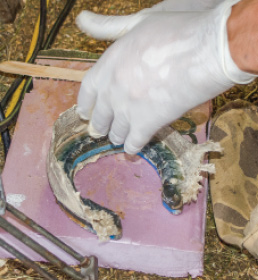
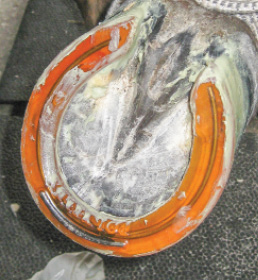
Manufacturers of shock-absorbing shoes include Sound Horse Technologies with its Series I and III shoes. These have urethane rim pads and are glued on with fabric cuffs (Figure 4). They have been around for a long time and been found to be very beneficial for many horses. Urethane shoes that are directly glued on also are manufactured by Sound Horse Technologies and Polyflex Horseshoes (Figure 5). They come in a variety of styles and are becoming very popular.
Composite shoes are hybrids composed of aluminum and urethane. The Equithotics Sneaker (Figure 6) is a nail-on shoe composed of an aluminum plate core covered with Equithane. It is very versatile and can be used for many different applications. The PG shoe is a Swedish import popular with the harness horse folks. It consists of an aluminum plate that’s applied to the foot with special nails and then a variety of pads that can be modified and attached with small bolts.
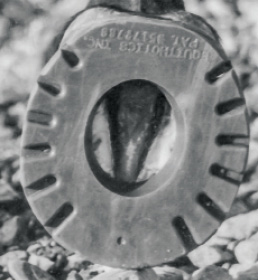
The development of different types of urethanes has dramatically changed our options for hoof care. The ability to combine different types of densities in a prosthetic device has made it possible to provide a harder and durable front portion of the shoe, as well as a softer, cushioned heel area. Epona uses five different densities in their shoes to provide durability and softness within the same shoe.
Tenderhoof Solutions’ Yasha shoe uses this concept to provide the ultimate in durability and comfort in a rim pad. The front part of the shoe is bonded with a high-density urethane rim, while the quarters and heels contain softer material. These rim pads can be applied to any steel or aluminum shoe with nails or glue.
Soft pours. The advantage of urethane or dental impression material over a conventional pad is that they do not add length to the foot and they adhere to the bottom of the foot. They are very popular with competitors whose horses compete at speed or show that require a long, low stride.
The urethane or dental impression material is poured or molded into the area beneath the sole and between the inner rim of the shoe. Do not fill the bottom of the foot level with the shoe. First, it reduces traction and can be dangerous to use on short, wet grass.
The other reason is that I have observed sole bruising, which I attribute to too much direct concussion. A better plan is to have the soft pour material at least 1/8 of an inch above the bottom of the shoe to about the third or fourth nail hole. At the back of the shoe, the soft pour material can extend to the ground with no problems. In fact, it’s best to do so to get the full effect of frog loading.
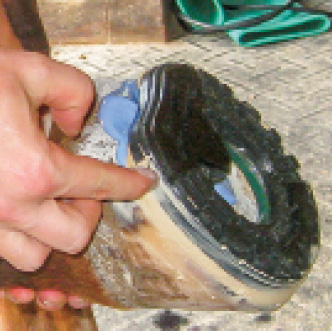
The Epona shoe, in conjunction with Vettec Super Soft, helps the horse’s hoof absorb shock.
Retailers of quality impression materials include: Nanric’s Advance Cushion Support kit, Equilox’s Hoof Support Impression Material, Victory Racing Plate Co.’s Ortho-Pak Silicone Putty, EDSS’ Soft Sole Support Impression Material, Equicast’s Ortho-Pak Silicone Putty and Sound Horse Technologies’ Equi Flex-Pak.
Orthotic devices. Some orthotic devices for horses are very similar to soft pour but are made to be removable and easily replaceable. For show horses with support issues, a removable orthotic device can be very therapeutic.
To make them, first coat the bottom of the foot with hoof oil. Next, a mixture of dental impression material or Vettec’s Equi-Pak Soft is placed in the bottom of the foot. After it has set up, gently remove it and trim the edges so it can be easily taken out and replaced. When the horse is in the stall, the material is left in the foot and held in place with VetRap or Elastikon and is taken out when the horse is ridden.
A similar option is to use Hoof Trax gel pads, which also are nailed on like a conventional pad.
Soft Ride hoof boots have been gaining wide acceptance in recent years for their ability to increase comfort in horses with acute and chronic conditions. They have a wide range of sizes, so getting a good fit is easy. Orthotic inserts are available in several densities and dual-density combinations.
Besides being recommended for horses with acute and chronic laminitis, these boots have been found to be very effective in preventing soreness in horses that are regularly shipped long distances. They also get rave reviews from the rodeo crowd.
Sole protection. There are several ways to provide protection for a sensitive sole. The easiest is to toughen the sole with products that draw moisture out of the sole, thus hardening it and making it less sensitive. My favorite is Durasole, which is made by Alvin Farrier Supply. Unfortunately, this process can take a few days to work and if the horse lives in moist conditions, it requires ongoing treatment on a daily basis.
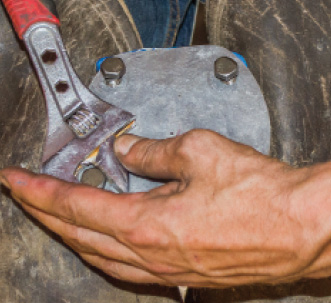
Hospital plates. Occasionally a horse will just need temporary protection for thin or sore soles that cannot tolerate any kind of pressure. The most common application is bolting on a 1/8 to 1/4 aluminum plate (Figure 7) and securing it with 1/4- to 3/8-inch bolts. Another option is to use a Castle Plastics Hospital Pad or a Grand Circuit Peek-A-Boo. These two options allow you access to the bottom of the foot without disturbing the shoe to treat the foot.
Hard pads. A more permanent fix is to use a pad sandwiched between the hoof and shoe to provide instant protection. The downside is that they add length and weight to the foot, and they can harbor bacteria that can lead to thrush if not packed carefully. When using pads, I’m a big advocate of employing a frog support pad and either urethane or dental impression packing.
Materials used for flat or wedge pads include leather, urethane of various densities and aluminum.
Partial pads include Grand Circuit’s aluminum Stabilizer, also know as a spider pad, and the Protector, also known as an expansion pad. The Stabilizer provides protection across the center of the foot and the Protector plate protects more of the rear part of the foot. Both can be nailed on or welded if you are using them with an aluminum shoe.
Non-Farrier Involvement
I always emphasize that keeping a horse sound is a team effort of owner, trainer, rider, vet, farrier, grooms and possibly acupuncturist and chiropractor all working together on the same page. Most problems cannot be fixed with shoeing alone.
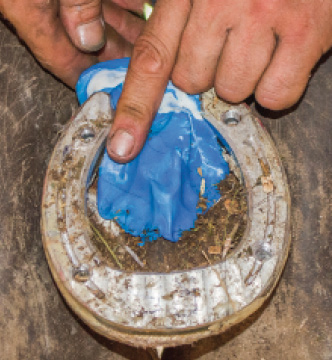
Dental impression material is a popular option because it doesn’t add length and it molds easily to the bottom of the foot.
What vets can do. The veterinarian is an indispensable part of the team because of their diagnostic capabilities, such as the ability to take radiographs and administer nerve blocks. They also can administer prescription therapeutic medicine such as joint injections, non-steroidal anti-inflammatory drugs and acupuncture and chiropractic care.
What owners can do. There is no substitute for good, stable management on a daily basis. This includes good turn out, proper nutrition, a good fitness and training routine and care after exercise, such as leg wrapping and icing.
Ongoing Challenge
A big problem with good horses is that after years and years of training, they get old and wear out just when they really know their job and are extremely reliable. But with advances in medicine and farriery, it’s now possible to extend the useful life of a horse more than ever before. When I started shoeing, it was uncommon to see a 30-year-old horse. Now, it’s not uncommon to see horses in their mid-30s still being used. It’s a credit to our profession to be a part of this accomplishment. Learn to use all the products and innovations out there.
Trying to keep horses sound is an ongoing challenge because of several factors all working against us. It is discouraging to have a horse improve and then relapse back to its former unsoundness. That’s why it’s important to keep an open mind and continue experimenting with different products on the market. You might not hit a home run every time, but you can still keep the horse in the game. Your clients and their horses are the big beneficiaries. Keep slugging away.

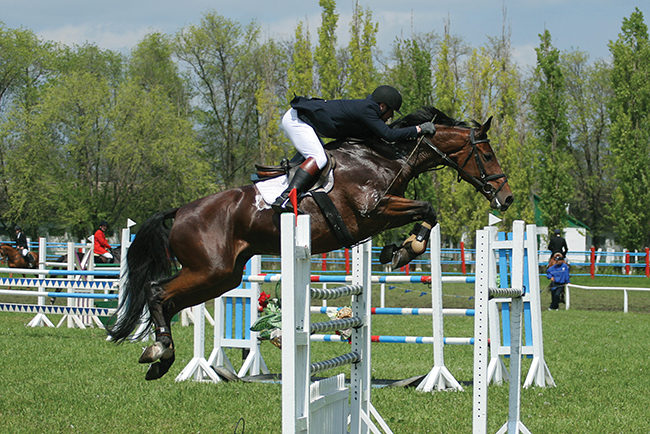







Post a comment
Report Abusive Comment